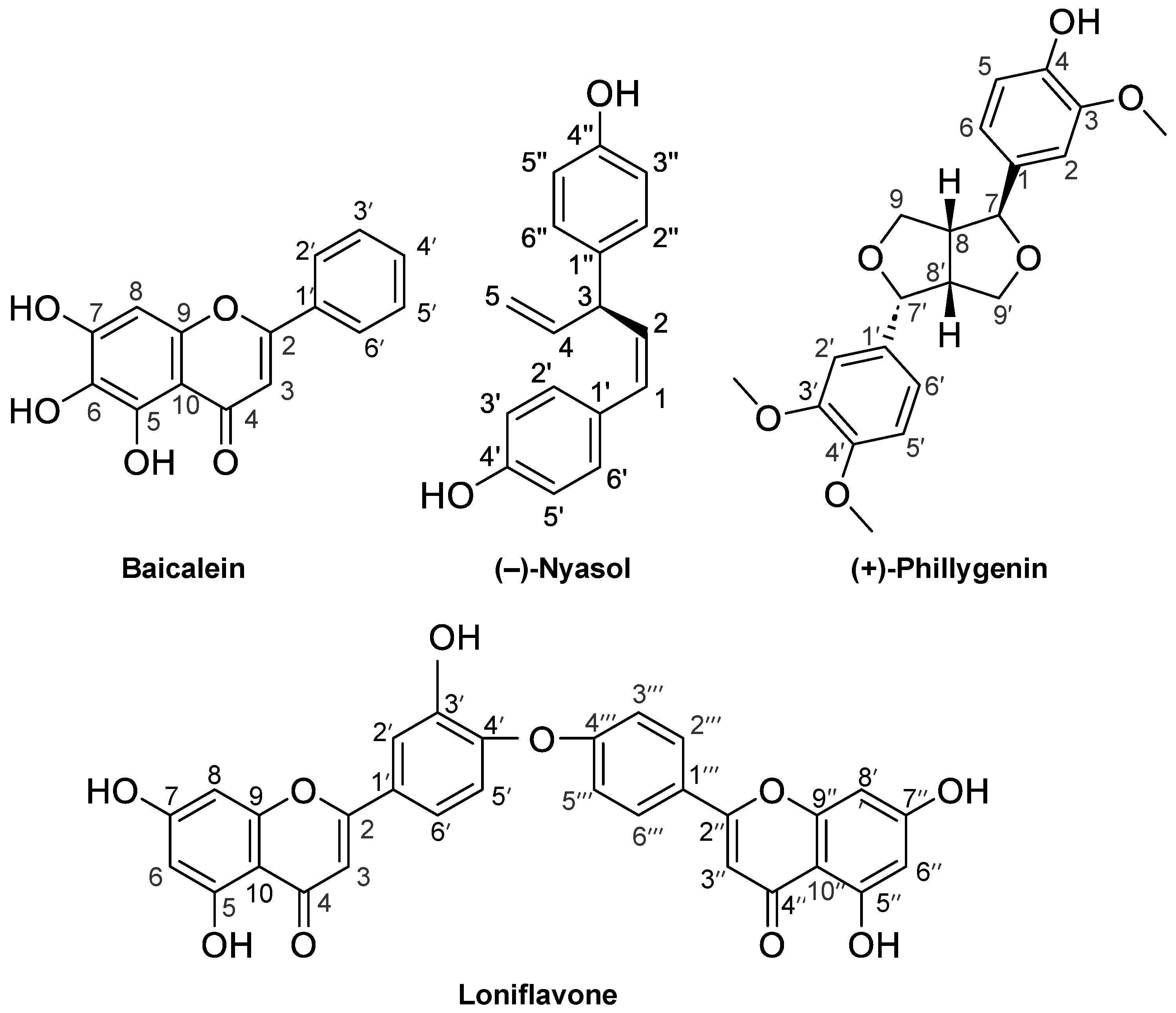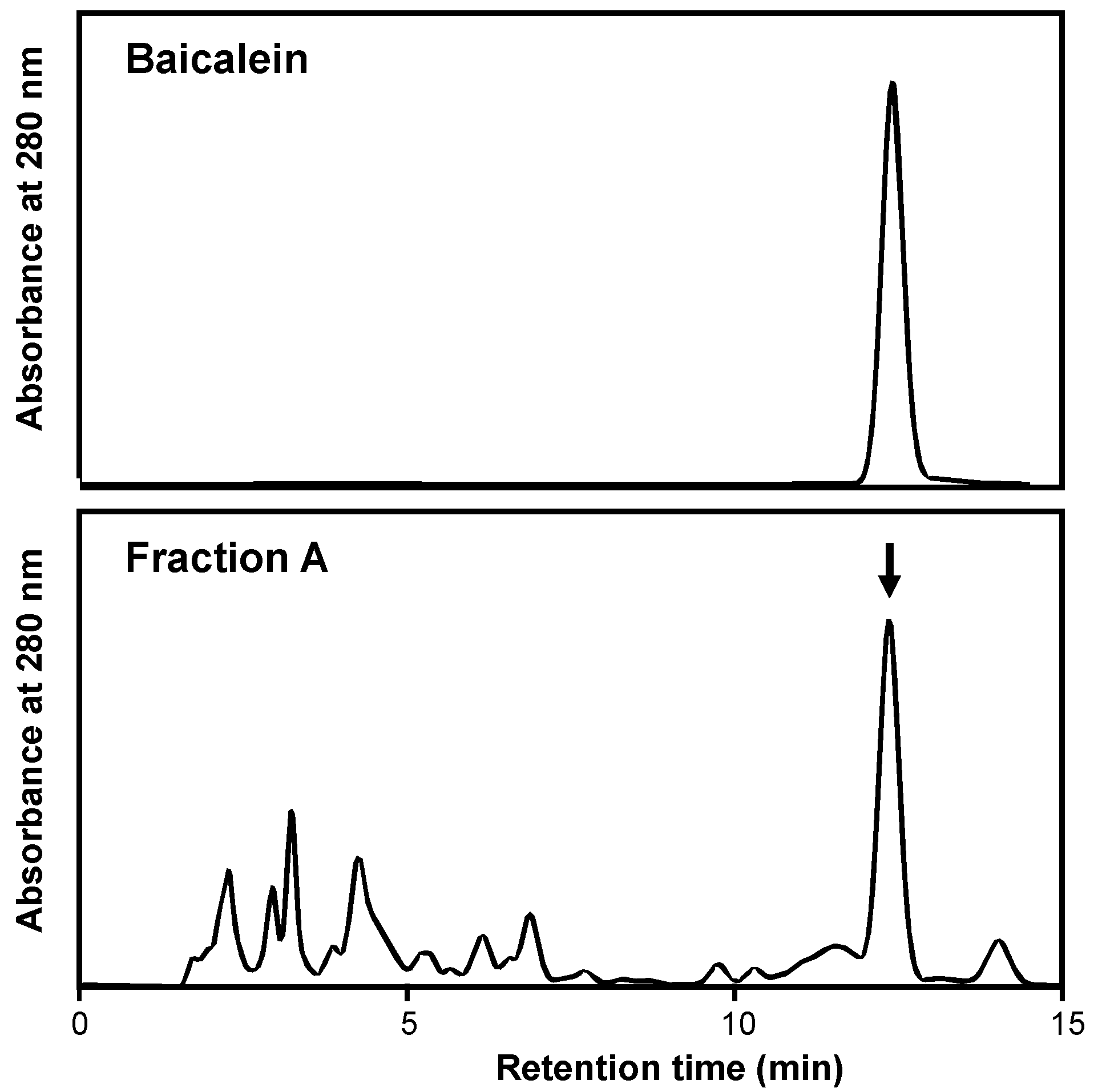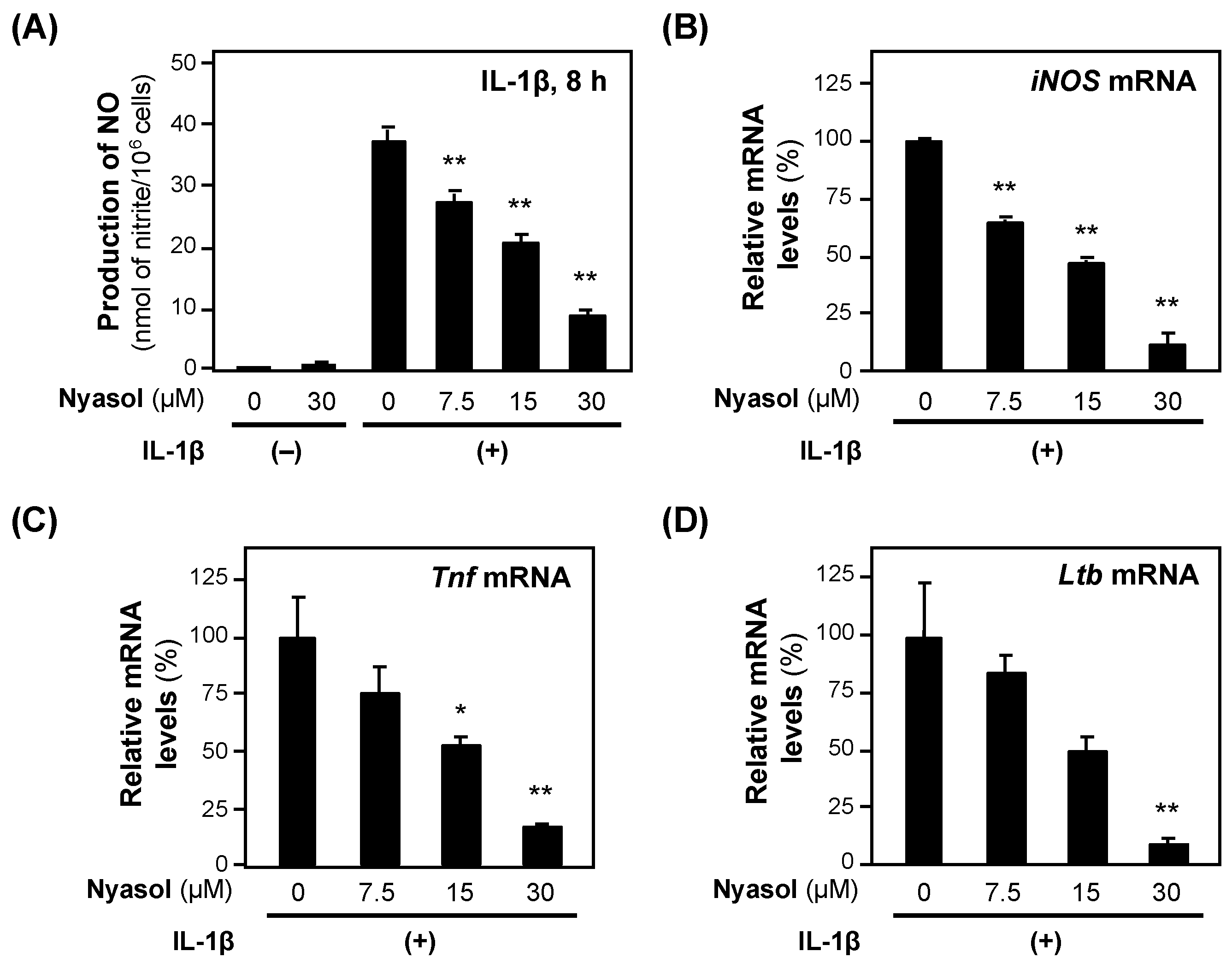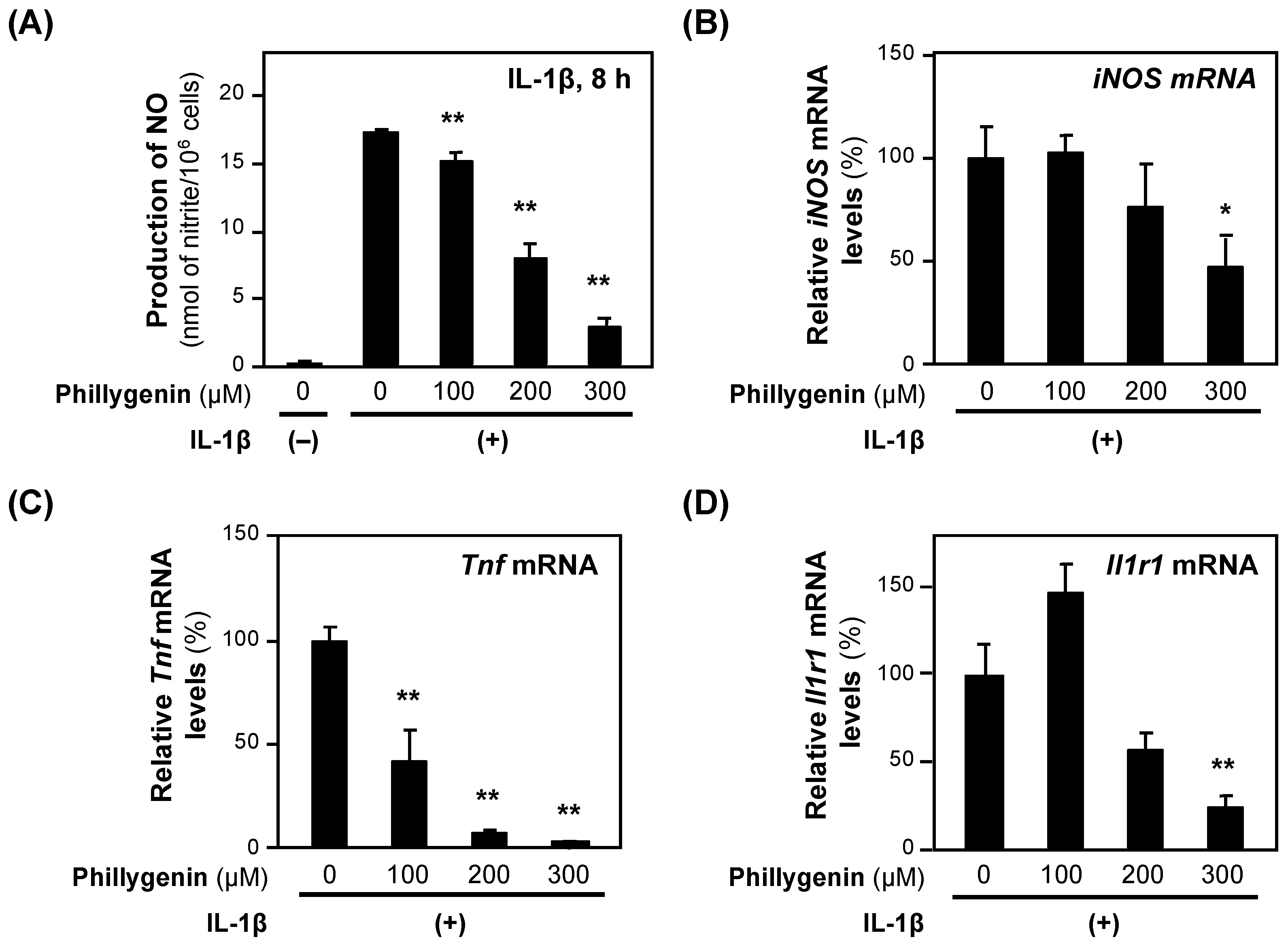Crude Drugs for Clearing Heat Contain Compounds Exhibiting Anti-Inflammatory Effects in Interleukin-1β-Treated Rat Hepatocytes
Abstract
:1. Introduction
2. Results
2.1. Extraction and Fractionation of Crude Drugs
2.2. Effects of the Fractions on the Suppression of NO Production in Hepatocytes
2.3. Purification of Anti-Inflammatory Compounds from Crude Drugs
2.3.1. Genipin and Geniposide of Gardenia Fruits
2.3.2. Purification of Baicalin from Scutellaria Roots
2.3.3. Purification of (−)-Nyasol from Anemarrhena Rhizomes
2.3.4. Purification of Loniflavone from Lonicera Leaves and Stems
2.4. Unsuccessful Purification of Anti-Inflammatory Compounds
2.5. Identification of an Anti-Inflammatory Compound by Removing Masking Compounds
3. Discussion
4. Materials and Methods
4.1. General Experimental Procedures and Reagents
4.2. Plant Materials
4.3. Extraction and Crude Fractionation
4.4. Purification of Anti-Inflammatory Compounds
4.5. Measuring the Content of Compounds
4.6. TLC and p-Anisaldehyde–Sulfuric Acid Color Reactions
4.7. Animals and Primary-Cultured Rat Hepatocytes
4.8. NO Assay and LDH Activity
4.9. Immunoblot Analysis
4.10. RT–qPCR
4.11. Statistical Analysis
5. Conclusions
Supplementary Materials
Author Contributions
Funding
Institutional Review Board Statement
Informed Consent Statement
Data Availability Statement
Acknowledgments
Conflicts of Interest
References
- Ikeya, Y.; Epp, D.A.; Nishizawa, M. Anti-inflammatory effect of foods and crude drugs in relation to bitter and spicy tastes. Bioact. Compd. Health Dis. 2019, 2, 77–93. [Google Scholar] [CrossRef]
- Borchardt, J.K. Traditional Chinese drug therapy. Drug News Perspect. 2003, 16, 698–702. [Google Scholar] [CrossRef] [PubMed]
- The Committee on the Japanese Pharmacopoeia. The Japanese Pharmacopoeia, 18th ed.; The Minister of Health, Labour and Welfare: Tokyo, Japan, 2021; Available online: https://www.mhlw.go.jp/content/11120000/000912390.pdf (accessed on 7 January 2025).
- Cheng, J.T. Review: Drug therapy in Chinese traditional medicine. J. Clin. Pharmacol. 2000, 40, 445–450. [Google Scholar] [CrossRef]
- Nemoto, Y. (Ed.) Explanation of Crude Drugs in 294 Kampo Formulae, 2nd ed.; Jiho, Inc.: Tokyo, Japan, 2021; ISBN 978-4840754002. (In Japanese) [Google Scholar]
- KEGG BRITE, Traditional Chinese Medicine in Japan. Available online: https://www.kegg.jp/kegg-bin/show_brite?br08304.keg (accessed on 7 January 2025).
- Fujii, A.; Okuyama, T.; Wakame, K.; Okumura, T.; Ikeya, Y.; Nishizawa, M. Identification of anti-inflammatory constituents in Phellodendri Cortex and Coptidis Rhizoma by monitoring the suppression of nitric oxide production. J. Nat. Med. 2017, 71, 745–756. [Google Scholar] [CrossRef] [PubMed]
- Sato, T.; Okuyama, T.; Ikeya, Y.; Nishizawa, M. Anti-inflammatory effects of hydrophobic constituents in the extract of the root cortex of Paeonia suffruticosa. Bioact. Compd. Health Dis. 2022, 5, 160–173. [Google Scholar] [CrossRef]
- Ohno, N.; Yoshigai, E.; Okuyama, T.; Yamamoto, Y.; Okumura, T.; Sato, K.; Ikeya, Y.; Nishizawa, M. Chlorogenic acid from the Japanese herbal medicine Kinginka (Flos Lonicerae japonicae) suppresses the expression of inducible nitric oxide synthase in rat hepatocytes. HOAJ Biol. 2012, 1, 2. [Google Scholar] [CrossRef]
- Nakatake, R.; Tsuda, T.; Matsuura, T.; Miki, H.; Hishikawa, H.; Matsushima, H.; Ishizaki, M.; Matsui, K.; Kaibori, K.; Nishizawa, M.; et al. Genipin Inhibits the Induction of Inducible Nitric Oxide Synthase Through the Inhibition of NF-κB Activation in Rat Hepatocytes. Drug Metab. Lett. 2017, 10, 254–263. [Google Scholar] [CrossRef] [PubMed]
- Koo, H.J.; Song, Y.S.; Kim, H.J.; Lee, Y.H.; Hong, S.M.; Kim, S.J.; Kim, B.C.; Jin, C.; Lim, C.J.; Park, E.H. Antiinflammatory effects of genipin, an active principle of gardenia. Eur. J. Pharmacol. 2004, 495, 201–208. [Google Scholar] [CrossRef]
- Kim, H.J.; Park, W. Alleviative Effect of Geniposide on Lipopolysaccharide-Stimulated Macrophages via Calcium Pathway. Int. J. Mol. Sci. 2024, 25, 1728. [Google Scholar] [CrossRef] [PubMed]
- Kitade, H.; Sakitani, K.; Indue, K.; Masu, Y.; Kawada, N.; Hiramatsu, Y.; Kamiyama, Y.; Okumura, T.; Ito, S. Interleukin 1β Markedly Stimulates Nitric Oxide Formation in the Absence of Other Cytokines or Lipopolysaccharide in Primary Cultured Rat Hepatocytes but Not in Kupffer Cells. Hepatology 1996, 23, 797–802. [Google Scholar] [CrossRef] [PubMed]
- Inaba, H.; Yoshigai, E.; Okuyama, T.; Murakoshi, M.; Sugiyama, K.; Nishino, H.; Nishizawa, M. Antipyretic Analgesic Drugs Have Different Mechanisms for Regulation of the Expression of Inducible Nitric Oxide Synthase in Hepatocytes and Macrophages. Nitric Oxide 2015, 44, 61–70. [Google Scholar] [CrossRef] [PubMed]
- Facchin, B.M.; Dos Reis, G.O.; Vieira, G.N.; Mohr, E.T.B.; da Rosa, J.S.; Kretzer, I.F.; Demarchi, I.G.; Dalmarco, E.M. Inflammatory biomarkers on an LPS-induced RAW 264.7 cell model: A systematic review and meta-analysis. Inflamm. Res. 2022, 71, 741–758. [Google Scholar] [CrossRef] [PubMed]
- Jiang, X.Y.; Li, X.C.; Liu, W.Y.; Xu, Y.H.; Feng, F.; Qu, W. An efficient, scalable approach to hydrolyze flavonoid glucuronides via activation of glycoside bond. Tetrahedron 2017, 73, 1895–1903. [Google Scholar] [CrossRef]
- Zheng, Y.; Zhou, S.; Zhang, H.; Lu, Z.; Deng, R.; Feng, Y.; Liu, P. Comparative Study of the Flavonoid Content in Radix Scutellaria from Different Cultivation Areas in China. Int. J. Anal. Chem. 2023, 2023, 3754549. [Google Scholar] [CrossRef]
- Matsui, K.; Nishizawa, M.; Ozaki, T.; Kimura, T.; Hashimoto, I.; Yamada, M.; Kaibori, M.; Kamiyama, Y.; Ito, S.; Okumura, T. Natural Antisense Transcript Stabilizes Inducible Nitric Oxide Synthase Messenger RNA in Rat Hepatocytes. Hepatology 2008, 30, 9–16. [Google Scholar] [CrossRef] [PubMed]
- Bae, G.; Yu, J.R.; Lee, J.; Chang, J.; Seo, E.K. Identification of nyasol and structurally related compounds as the active principles from Anemarrhena asphodeloides against respiratory syncytial virus (RSV). Chem. Biodivers. 2007, 4, 2231–2235. [Google Scholar] [CrossRef]
- Minami, E.; Taki, M.; Takaishi, S.; Iijima, Y.; Tsutumi, S.; Akiyama, T. Stereochemistry of cis- and trans-Hinokiresinol and Their Estrogen-like Activity. Chem. Pharm. Bull. 2000, 48, 389–392. [Google Scholar] [CrossRef] [PubMed]
- Bahia, M.V.; David, J.P.; David, J.M. Occurrence of biflavones in leaves of Caesalpinia pyramidalis specimens. Quím. Nova 2010, 33, 1297–1300. [Google Scholar] [CrossRef]
- Yamauchi, Y.; Okuyama, T.; Ishii, T.; Okumura, T.; Ikeya, Y.; Nishizawa, M. Sakuranetin Downregulates Inducible Nitric Oxide Synthase Expression by Affecting Interleukin-1 Receptor and CCAAT/Enhancer-Binding Protein β. J. Nat. Med. 2019, 73, 353–368. [Google Scholar] [CrossRef]
- KEGG, DRUG: Rehmannia Root. Available online: https://www.kegg.jp/entry/D06736 (accessed on 7 January 2025).
- Ren, T.; Xu, Z. Study of isomeric pentacyclic triterpene acids in traditional Chinese medicine of Forsythiae Fructus and their binding constants with β-cyclodextrin by capillary electrophoresis. Electrophoresis 2018, 39, 1006–1013. [Google Scholar] [CrossRef] [PubMed]
- Lee, S.M.; Min, B.S.; Lee, C.G.; Kim, K.S.; Kho, Y.H. Cytotoxic triterpenoids from the fruits of Zizyphus jujuba. Planta Med. 2003, 69, 1051–1054. [Google Scholar] [CrossRef] [PubMed]
- Bai, L.; Zhang, H.; Liu, Q.; Zhao, Y.; Cui, X.; Guo, S.; Zhang, L.; Ho, C.T.; Bai, N. Chemical characterization of the main bioactive constituents from fruits of Ziziphus jujuba. Food Funct. 2016, 7, 2870–2877. [Google Scholar] [CrossRef]
- Rahman, M.M.A.; Dewick, P.M.; Jackson, D.E.; Lucas, J.A. Lignans of Forsythia intermedia. Phytochemistry 1990, 29, 1971–1980. [Google Scholar] [CrossRef]
- Chang, M.J.; Hung, T.M.; Min, B.S.; Kim, J.C.; Woo, M.H.; Choi, J.S.; Lee, H.K.; Bae, K.H. Lignans from the Fruits of Forsythia suspensa (Thunb.) Vahl Protect High-Density Lipoprotein during Oxidative Stress. Biosci. Biotechnol. Biochem. 2008, 72, 2750–2755. [Google Scholar] [CrossRef] [PubMed]
- Tracy, R.P. The five cardinal signs of inflammation: Calor, Dolor, Rubor, Tumor … and Penuria (Apologies to Aulus Cornelius Celsus, De medicina, c. A.D. 25). J. Gerontol. A Biol. Sci. Med. Sci. 2006, 61, 1051–1052. [Google Scholar] [CrossRef] [PubMed]
- Dinda, B.; Dinda, S.; DasSharma, S.; Banik, R.; Chakraborty, A.; Dinda, M. Therapeutic potentials of baicalin and its aglycone, baicalein against inflammatory disorders. Eur. J. Med. Chem. 2017, 131, 68–80. [Google Scholar] [CrossRef]
- Sabry, K.; Jamshidi, Z.; Emami, S.A.; Sahebka, A. Potential therapeutic effects of baicalin and baicalein. Avicenna J. Phytomed. 2024, 14, 23–49. [Google Scholar] [CrossRef]
- Wang, C.; Wu, R.; Zhang, S.; Gong, L.; Fu, K.; Yao, C.; Peng, C.; Li, Y. A comprehensive review on pharmacological, toxicity, and pharmacokinetic properties of phillygenin: Current landscape and future perspectives. Biomed. Pharmacother. 2023, 166, 115410. [Google Scholar] [CrossRef]
- Kumar, N.; Singh, B.; Bhandari, P.; Gupta, A.P.; Uniyal, S.K.; Kaul, V.K. Biflavonoids from Lonicera japonica. Phytochemistry 2005, 66, 2740–2744. [Google Scholar] [CrossRef] [PubMed]
- Akao, T.; Kobashi, K.; Aburada, M. Enzymic studies on the animal and intestinal bacterial metabolism of geniposide. Biol. Pharm. Bull. 1994, 17, 1573–1576. [Google Scholar] [CrossRef]
- Yim, J.S.; Kim, Y.S.; Moon, S.K.; Cho, K.H.; Bae, H.S.; Kim, J.J.; Park, E.K.; Kim, D.H. Metabolic activities of ginsenoside Rb1, baicalin, glycyrrhizin and geniposide to their bioactive compounds by human intestinal microflora. Biol. Pharm. Bull. 2004, 27, 1580–1583. [Google Scholar] [CrossRef] [PubMed]
- Wang, W.; Wang, Y.; Liu, M.; Zhang, Y.; Yang, T.; Li, D.; Huang, Y.; Li, Q.; Bai, G.; Shi, L. Betulinic acid induces apoptosis and suppresses metastasis in hepatocellular carcinoma cell line in vitro and in vivo. J. Cell. Mol. Med. 2019, 23, 585–595. [Google Scholar] [CrossRef] [PubMed]
- Jiang, W.; Li, X.; Dong, S.; Zhou, W. Betulinic acid in the treatment of tumour diseases: Application and research progress. Biomed. Pharmacother. 2021, 142, 111990. [Google Scholar] [CrossRef] [PubMed]
- Ishii, T.; Okuyama, T.; Noguchi, N.; Nishidono, Y.; Okumura, T.; Kaibori, M.; Tanaka, K.; Terabayashi, S.; Ikeya, Y.; Nishizawa, M. Antiinflammatory constituents of Atractylodes chinensis rhizome improve glomerular lesions in immunoglobulin A nephropathy model mice. J. Nat. Med. 2020, 74, 51–64. [Google Scholar] [CrossRef] [PubMed]
- Lee, E.J.; Chung, H.J.; Pyee, Y.; Hong, J.Y.; Youn, U.J.; Seo, E.K.; Lee, S.K. Suppression of Inducible Nitric Oxide Synthase Expression by Nyasol and Broussonin A, Two Phenolic Compounds from Anemarrhena asphodeloides, through NF-kB Transcriptional Regulation in vitro and in vivo. Chem. Biodivers. 2014, 11, 749–759. [Google Scholar] [CrossRef]
- Zhou, M.; Tang, Y.; Liao, L.; Liu, M.; Deng, Y.; Zhao, X.; Li, Y. Phillygenin inhibited LPS-induced RAW 264.7 cell inflammation by NF-κB pathway. Eur. J. Pharmacol. 2021, 899, 174043. [Google Scholar] [CrossRef] [PubMed]
- Hu, N.; Wang, C.; Dai, X.; Zhou, M.; Gong, L.; Yu, L.; Peng, C.; Li, Y. Phillygenin inhibits LPS-induced activation and inflammation of LX2 cells by TLR4/MyD88/NF-κB signaling pathway. J. Ethnopharmacol. 2020, 248, 112361. [Google Scholar] [CrossRef]
- Li, Y.; Wang, J.; Song, X.; Bai, H.; Ma, T.; Zhang, Z.; Li, X.; Jiang, R.; Wang, G.; Fan, X.; et al. Effects of baicalein on IL-1β-induced inflammation and apoptosis in rat articular chondrocytes. Oncotarget 2017, 8, 90781–90795. [Google Scholar] [CrossRef]
- Liao, H.; Ye, J.; Gao, L.; Liu, Y. The main bioactive compounds of Scutellaria baicalensis Georgi. for alleviation of inflammatory cytokines: A comprehensive review. Biomed. Pharmacother. 2021, 133, 110917. [Google Scholar] [CrossRef] [PubMed]
- Okuyama, T.; Nakatake, R.; Ito, K.; Ishizaki, M.; Yanagida, H.; Kitade, H.; Yoshizawa, K.; Ikeya, Y.; Nishizawa, M.; Sekimoto, M. Hepatoprotective effects of baicalein against liver ischemia-reperfusion injury and partial hepatectomy in a rat model. Mol. Biol. Rep. 2024, 51, 643. [Google Scholar] [CrossRef]
- Leonti, M.; Casu, L. Traditional medicines and globalization: Current and future perspectives in ethnopharmacology. Front. Pharmacol. 2013, 4, 92. [Google Scholar] [CrossRef] [PubMed]
- Chen, M.; Liu, Y.; Yang, Y.; Qiu, Y.; Wang, Z.; Li, X.; Zhang, W. Emerging roles of activating transcription factor (ATF) family members in tumourigenesis and immunity: Implications in cancer immunotherapy. Genes Dis. 2021, 9, 981–999. [Google Scholar] [CrossRef] [PubMed]
- Subramaniam, M.; Hawse, J.R.; Rajamannan, N.M.; Ingle, J.N.; Spelsberg, T.C. Functional role of KLF10 in multiple disease processes. Biofactors 2010, 36, 8–18. [Google Scholar] [CrossRef]
- Galic, S.; Sachithanandan, N.; Kay, T.W.; Steinberg, G.R. Suppressor of cytokine signalling (SOCS) proteins as guardians of inflammatory responses critical for regulating insulin sensitivity. Biochem. J. 2014, 461, 177–188. [Google Scholar] [CrossRef] [PubMed]
- Ramanan, M.; Sinha, S.; Sudarshan, K.; Aidhen, I.S.; Doble, M. Inhibition of the enzymes in the leukotriene and prostaglandin pathways in inflammation by 3-aryl isocoumarins. Eur. J. Med. Chem. 2016, 124, 428–434. [Google Scholar] [CrossRef]
- Sudarshan, K.; Boda, A.K.; Dogra, S.; Bose, I.; Yadav, P.N.; Aidhen, I.S. Discovery of an isocoumarin analogue that modulates neuronal functions via neurotrophin receptor TrkB. Bioorg. Med. Chem. Lett. 2019, 29, 585–590. [Google Scholar] [CrossRef] [PubMed]
- Muso, E.; Yoshida, H.; Takeuchi, E.; Yashiro, M.; Matsushima, H.; Oyama, A.; Suyama, K.; Kawamura, T.; Kamata, T.; Miyawaki, S.; et al. Enhanced production of glomerular extracellular matrix in a new mouse strain of high serum IgA ddY mice. Kidney Int. 1996, 50, 1946–1957. [Google Scholar] [CrossRef] [PubMed]
- Shirako, S.; Ulfa, S.M.; Nishidono, Y.; Dwijayanti, D.R.; Okuyama, T.; Nakatake, R.; Tanaka, K.; Ikeya, Y.; Nishizawa, M. Hydrophobic constituents of Polygonum multiflorum roots promote renal erythropoietin expression in healthy mice. J. Nat. Med. 2023, 77, 880–890. [Google Scholar] [CrossRef] [PubMed]
- Kanemaki, T.; Kitade, H.; Hiramatsu, Y.; Kamiyama, Y.; Okumura, T. Stimulation of Glycogen Degradation by Prostaglandin E2 in Primary Cultured Rat Hepatocytes. Prostaglandins 1993, 45, 459–474. [Google Scholar] [CrossRef]
- Ozaki, H.; Nishidono, Y.; Fujii, A.; Okuyama, T.; Nakamura, K.; Maesako, T.; Shirako, S.; Nakatake, R.; Tanaka, K.; Ikeya, Y.; et al. Identification of Anti-Inflammatory Compounds from Peucedanum praeruptorum Roots by Using Nitric Oxide-Producing Rat Hepatocytes Stimulated by Interleukin 1β. Molecules 2023, 28, 5076. [Google Scholar] [CrossRef]
- Green, L.C.; Wagner, D.A.; Glogowski, J.; Skipper, P.L.; Wishnok, J.S.; Tannenbaum, S.R. Analysis of Nitrate, Nitrite, and [15N]Nitrate in Biological Fluids. Anal. Biochem. 1982, 126, 131–138. [Google Scholar] [CrossRef]








| Crude Drug | Japanese Name | Description | Family |
|---|---|---|---|
| Phellodendron bark | Obaku | Bark of Phellodendron amurense Ruprecht, or P. chinense Schneider | Rutaceae |
| Coptis rhizome | Oren | Rhizome of Coptis japonica Makino, C. chinensis Franchet, C. deltoidea C.Y. Cheng et Hsiao, or C. teeta Wallich | Ranunculaceae |
| Paeonia suffruticosa root bark (moutan bark) | Botanpi | Root bark of Paeonia suffruticosa Andrews | Paeoniaceae |
| Lonicera flower | Kinginka | Flower and bud of Lonicera japonica Thunberg | Caprifoliaceae |
| Gardenia fruit | Sanshishi | Fruit of Gardenia jasminoides Ellis | Rubiaceae |
| Scutellaria root | Ogon | Root of Scutellaria baicalensis Georgi | Labiatae |
| Anemarrhena rhizome | Chimo | Rhizome of Anemarrhena asphodeloides Bunge | Liliaceae |
| Lonicera leaf and stem | Nindo | Leaf and stem of Lonicera japonica Thunberg | Caprifoliaceae |
| Rehmannia root | Jio | Root of Rehmannia glutinosa Liboschitz var. purpurea Makino, or R. glutinosa Liboschitz | Scrophulariaceae |
| Forsythia fruit | Rengyo | Fruit of Forsythia suspensa Vahl | Oleaceae |
| Crude Drug | Extraction Yield (%) 1 | Fraction A | Fraction B | Fraction C | Reference | |||
| Ratio (%) 2 | IC50 (µg/mL) 3 | Ratio (%) 2 | IC50 (µg/mL) 3 | Ratio (%) 2 | IC50 (µg/mL) 3 | |||
| Phellodendron bark | 19.7 | --- * | --- * | --- * | [7] | |||
| Coptis rhizome | 18.0 | --- * | --- * | --- * | [7] | |||
| Moutan bark | 25.9 | 22.2 | 8.97 ± 0.06 | 9.93 | 141 ± 23.5 | 67.9 | NA | [8] |
| Lonicera flower | 34.5 | 11.1 | 126 ± 30 | 16.4 | 993 ± 327 | 72.5 | >2000 | [9] |
| Gardenia fruit 4 | 24.3 | 29.6 | 231 ± 20.3 | 41.4 | NA | 29.0 | NA | This study |
| Scutellaria root | 34.6 | 15.9 | 8.60 ± 2.07 | 22.5 | 55.3 ± 27.3 | 61.7 | 122 ± 24.3 | This study |
| Anemarrhena rhizome | 26.9 | 13.9 | 42.8 ± 7.56 | 24.3 | NA | 61.8 | NA | This study |
| Lonicera leaf and stem | 15.8 | 19.6 | 37.7 ± 3.16 | 29.5 | 233 ± 24.3 | 50.9 | NA | This study |
| Rehmannia root | 18.1 | 1.71 | 18.1 ± 2.83 | 5.68 | 128 ± 41.1 | 92.6 | 573 ± 247 | This study |
| Forsythia fruit | 8.93 | 58.0 | NC | 28.0 | 192 ± 13.9 | 14.0 | 556 ± 51.0 | This study |
| Crude Drug | Typical Compound | Classification | IC50 (μM) 1 | Reference |
|---|---|---|---|---|
| Phellodendron bark | Obakunone | Limonoid | 2.6 ± 1.1 | [7] |
| Coptis rhizome | Berberine | Alkaloid | 12.0 ± 3.4 | [7] |
| Moutan bark | 1,2,3,4,6-Pentagalloyl-β-D-glucose | Tannin | 2.67 ± 0.36 | [8] |
| Lonicera flower | Chlorogenic acid | Phenylpropanoid | 652 ± 114 | [9] |
| Gardenia fruit | Genipin | Iridoid | 4.40 ± 0.85 | This study |
| Scutellaria root | Baicalein | Flavonoid | 16.8 ± 7.93 | This study |
| Anemarrhena rhizome | (−)-Nyasol | Phenylpropanoid | 18.3 ± 2.99 | This study |
| Lonicera leaf and stem | Loniflavone | Flavonoid | 1.64 ± 0.17 | This study |
| Forsythia fruit | (+)-Phillygenin | Lignan | 193 ± 47.6 | This study |
Disclaimer/Publisher’s Note: The statements, opinions and data contained in all publications are solely those of the individual author(s) and contributor(s) and not of MDPI and/or the editor(s). MDPI and/or the editor(s) disclaim responsibility for any injury to people or property resulting from any ideas, methods, instructions or products referred to in the content. |
© 2025 by the authors. Licensee MDPI, Basel, Switzerland. This article is an open access article distributed under the terms and conditions of the Creative Commons Attribution (CC BY) license (https://creativecommons.org/licenses/by/4.0/).
Share and Cite
Fujii, A.; Onishi, S.; Watanabe, N.; Kajimura, M.; Ito, K.; Minamisaka, K.; Nishidono, Y.; Shirako, S.; Ikeya, Y.; Nishizawa, M. Crude Drugs for Clearing Heat Contain Compounds Exhibiting Anti-Inflammatory Effects in Interleukin-1β-Treated Rat Hepatocytes. Molecules 2025, 30, 416. https://doi.org/10.3390/molecules30020416
Fujii A, Onishi S, Watanabe N, Kajimura M, Ito K, Minamisaka K, Nishidono Y, Shirako S, Ikeya Y, Nishizawa M. Crude Drugs for Clearing Heat Contain Compounds Exhibiting Anti-Inflammatory Effects in Interleukin-1β-Treated Rat Hepatocytes. Molecules. 2025; 30(2):416. https://doi.org/10.3390/molecules30020416
Chicago/Turabian StyleFujii, Airi, Saki Onishi, Nodoka Watanabe, Mizuki Kajimura, Kentaro Ito, Keita Minamisaka, Yuto Nishidono, Saki Shirako, Yukinobu Ikeya, and Mikio Nishizawa. 2025. "Crude Drugs for Clearing Heat Contain Compounds Exhibiting Anti-Inflammatory Effects in Interleukin-1β-Treated Rat Hepatocytes" Molecules 30, no. 2: 416. https://doi.org/10.3390/molecules30020416
APA StyleFujii, A., Onishi, S., Watanabe, N., Kajimura, M., Ito, K., Minamisaka, K., Nishidono, Y., Shirako, S., Ikeya, Y., & Nishizawa, M. (2025). Crude Drugs for Clearing Heat Contain Compounds Exhibiting Anti-Inflammatory Effects in Interleukin-1β-Treated Rat Hepatocytes. Molecules, 30(2), 416. https://doi.org/10.3390/molecules30020416








